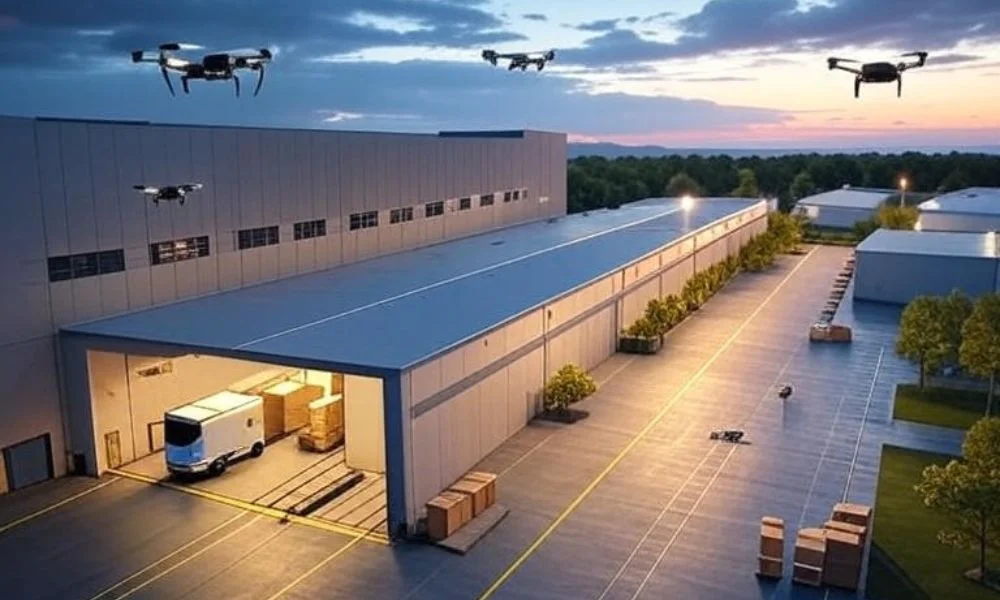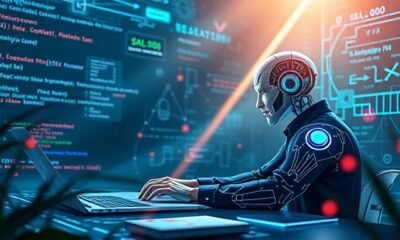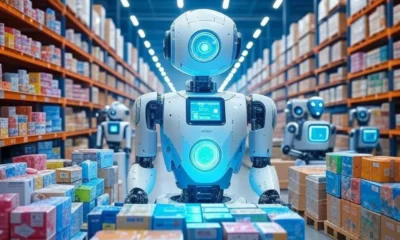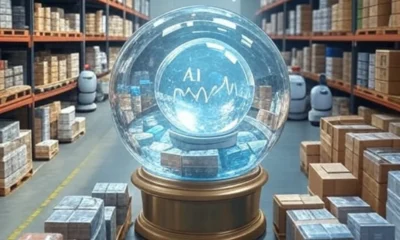Artificial Intelligence
Why AI in Logistics and Route Optimization Matters for the Future
I explore how AI is changing logistics and route optimization across the U.S. between 2025 and 2030. Learn about key trends, technologies, and industry-specific solutions shaping faster, smarter, and more sustainable logistics systems.

I always ask myself how my orders arrive at my doorstep in the shortest time possible every time I order something online. Artificial intelligence is the answer. Future of AI in logistics and route optimization is transforming how companies handle shipping across the U.S. Industry report predictions have posited AI driven logistics solutions to contribute to the creation of more than 70 billion dollars of global value by 2030.
Logistics were relying on old systems that are unable to cope up with the increase in costs, delays in delivery and customer frustrations. I have witnessed how legacy tools would fail in the actual scenario. Unforeseen traffic jams and weather conditions are impossible to predict with the help of traditional route planning. That is where artificial intelligence comes in, and it all goes upside down both in large businesses and logistics companies as well as in the small on.
Definition:
Logistics and route optimization AI can be defined as application of artificial intelligence technologies to plan, track and streamline shipping mechanisms effectively.
It implies the introduction of intelligent systems that would allow businesses cut the expenditure spent on fuel, skip traffic nightmares, and deliver goods in a much shorter period. I have confidence in these AI tools since they provide real-time updates, improved decision-making, and cost-saving in the long-run.
You will get to know where the industry is biting towards, which technologies have been turning things in that direction and why it is important to the business, such as mine and yours.
AI Situation in the Logistics Puzzle (In 2025):
Artificial intelligence in the field of logistics is no longer one of the latest trends, but a reality. I can see it everyday in my own business operations in the logistics industry. Businesses, both big and small, across the United States have implemented AI in a bid to reduce expenses and improve the delivery time. According to global reports, this is the degree to which logistics companies apply some type of AI in 2025 and the figure cannot be so low, exceeding 65 percent. This is already twice the number in the last five years and this indicates the pace at which adoption is increasing.
Which are the Most Popular AI applications in Logistics Now?
But when I cyclically look around what other professionals in the field of logistics use, there are four primary AI applications that become obvious:
Route Optimization:
AI will guide me to deliver products to customers via the shortest and fastest route, or the one that does not involve traffic jams, and construction delays.
Pre Delivery Time Predictive Analytics:
I also apply artificial intelligence tools that help me to predict the time a package will come and hence be on time to meet customer expectations.
Inventory Management:
Intelligent AI systems monitor inventories by themselves and I will not be faced with the shortage or the overstocking issues ever again.
Risk and Hazard Prediction:
AI warns me of potential dangers such as weather interference or roadblocks prior to them spoiling my shipping.
Which Are the Most Crucial Issues AI in Logistics has to Deal With Now:
Despite these advantages, not all is very rosy. Some of the very real difficulties in which firms such as mine has to work are:
Interaction with the Legacy Systems:
New AI technologies do not always perform well with the previously used older software and hardware systems. That causes bottle necks.
Security and privacy issues relating to data:
I must always consider keeping vital information about delivery and customers safe against cyber threats.
Skill shortage in Logistic workforce:
Most of the U.S. employees in the sphere of logistics require further training in terms of AI systems and their usage. Upskilling is still a big target.
AI/Route-optimisation in Logistics & Transport: Emerging Trends (2025-30):
I can imagine the field of logistics five years in the future; and AI seems like the largest changeup. Such are the new trends which demonstrate the speed of dynamics in the American market. Now, I would like to explain to you what is coming next and why it is important to the companies like mine or yours.
What Is Real-Time Adaptive Route Optimization?
Real-time adaptive route optimization based on AI is one of the tendencies that I consider very helpful. Rather than utilizing ready-made routes, AI automatically calculates changes of routes depending on the real-time situations.
e.g. in case some traffic congestion happens, or the weather conditions become quite unpredictable, my AI system redirects trucks immediately in order to save time and fuel. It even takes into consideration the cost of fuel or even new regulations in certain states, thus helping me to save unnecessary expenses. Such flexibility was unheard of in terms of previous tools.
What can Autonomous Delivery Vehicles and Drones bring to the logistics?
Are Self driving truck available on the road yet? I do, and they are getting more popular. Artificial intelligence is the reason why autonomous cars and transport drones exist today in logistics.
These vehicles are operated through AI systems that make them move safely and effectively, on streets and around obstacles. I have seen companies engaging in last mile drone deliveries in my business especially in urban centers where there is congestion as one of the most serious issues. These systems guarantee quicker and inexpensive delivery all over the country.
Why does it Matter? Why Predictive Hazard Detection and Risk Management?
There is one thing that I am always concerned about risks, accidents, bad weather, or political protests that can block roads. This is the problem, which is solved with predictive hazard detection with AI in my case.
AI systems can foretell any risks before they occur with the previous information, weather forecast, and real-time data. This assists me in preparing risk management plans before hand. I am more assured of the fact that AI reminds me of the disruptions to crease sufficiently in time instead of acting very late.
What Does the Integration of AI and IoT Do to Fleet Management?
Next big thing I continue hearing about is how to combine AI into IoT devices to make the fleet management smarter. That would be the case of me following every car in real time and anticipating the next maintenance.
Such AI enabled mechanisms also detect fuel consumption, tire inflation, and alteration of routes so that all the trucks can operate smoothly. It is not only the matter of technology it allows me to reduce expenses and be sure that nothing unforeseen can reduce my deliveries.
What Role Is Artificial Intelligence playing in Sustainable and Green Logistics?
There is no longer talk of sustainability being a buzzword. I am also aware that my customers are concerned with using shipment that is environmentally friendly, and AI can assist me with playing this role.
AI enhances the route planning so that it finds a better path to consume less fuel and decrease the carbon emission of my company. With smarter and better use of delivering techniques I not only save the environment, but I also save money. It is not good business, it is the right thing to do in the future.
Applications: AI Customizing Solutions to the Industry:
All logistics problems do not appear the same way. I have understood that AI is not one size fits all. Rather, it customizes tools across various industries. This is the use of AI in specifically some of the key sectors in the U.S.
What can AI do to aid E-commerce and Retail Logistics?
Volume of orders that one needs to process in order to run an online store today is in the thousands per day. That is where I rely on AI that will assist me in predicting customer demand and prevent delivery delays.
Demand Forecasting:
While shopping, AI systems will scan to determine the present trend of products purchases helping me stock goods in a more efficient way depending on what is likely to be purchased next.
Last-Mile Delivery Optimization:
In my case, AI can schedule quicker and less expensive last mile deliveries to a home, and it decreases the overall price and the delay.
What is the Role of AI in Enhancing Supply Chains in Healthcare?
Healthcare logistics has its own challenges which I consider seriously. Goods such as vaccines or life saving pharmacology have to be delivered within time and under prime terms.
Sensitive Shipments: As per the use of AI, it keeps track of temperature, humidity, and time to ensure sensitive medical products to remain safe until the delivery is made.
AI Route Planning with Urgency:
I use AI to make emergency healthcare deliveries more of a priority without affecting the rest of the previously scheduled deliveries.
Why is AI Essential in Manufacturing and Industrial Logistics?
Manufacturing supply chains are associated with heavy goods and short timings. More factories are relying on AI to maintain full supply chain transparency and stocks.
Real-Time Inventory Management:
AI automatically monitors raw materials as well as new goods, ensuring that none of them should become either lost or late:
I love the fact that I am able to tell the status of every shipment anywhere along the chain, whether it is on the factory floor or at the delivery dock.
Most Critical Technologies of AI in the Logistics (2025 2030):
There is always a technology behind every smart logistics solution that I use. These are the fundamental frameworks behind the rise of AI within the sphere of logistics in the U.S.
What Is the Role of Machine Learning and Predictive Analytics?
What I mean by AI in logistics is its brainpower which is provided by machine learning. I find the true value in predictive analytics in my day-to day practice.
Machine learning forecasts the exact time that each shipment arrives due to traffic and weather conditions and historical information.
Cost Forecasting:
I apply the predictive tools to calculate the cost of fuel, which enables me to make wiser budgeting decisions prior to the appearance of the problem.
How Does Computer Vision Enhance the Autonomous Vehicles?
Computer vision applied via AI is used to power self driving trucks. This technology identifies roads, obstructions and signs in real time.
Navigation:
AI can read what it sees through cameras and sensors to drive safely on the highway and in the city.
Safety Checks:
I understand, that computer vision prevents crashes due to the detection of hazards that human drivers may also overlook.
What Does Natural Language Processing Have to Do With Logistics?
Every time I communicate with a logistics chat bot, it is through NLP. In this way, with the help of such AI technology, I do not require additional attendants to perform customer service.
Chatbots:
I keep the AI chatbots going to reply to delivery questions made by customers as fast as possible and avoid phone calls and emails.
Voice Commands:
NLP enables voice commands, so that the driver can keep his or her hands on the wheel, but remain informed about what is going on the road.
What is the Value of Digital Twins and Simulation Platforms?
You can picture yourself trying out a different delivery route but without dispatching a real truck. That is what digital twins and simulations give to me.
VRT:
I perform AI based testing of previous routes to understand how the new delivery schedule will be working under various conditions.
Warehouse Layout Optimization:
AI digital twins will allow me to test warehouse layouts virtually, thus avoiding high physical changes.
Regional and Global Trends:
Rate of AI application in the logistics industry is not the same everywhere. I have observed that the three regions I have out (North America, Europe and Asia Pacific) are vastly different when it comes to implementing AI tools.
Which Country Is the Fastest to Adopt AI Logistics?
Adoption of AI logistics in the U.S. seems rampant. More firms including small ones such as mine and large players invest in AI annually.
Europe is much tighter when it comes to regulatory compliance and Asia-Pacific when it comes to innovative technologies and pilots. I also think that North America is balanced on speed and regulation.
What Role Does Policy and Regulations Play on the Development of AI Logistics?
Being up to date with the ever changing AI regulations is one of my challenges. U.S. government is also revising recommendations of data privacy and autonomous vehicles.
In Europe, scenarios are similar as AI logistics policies are aimed toward ethics and the environment. Asia Pacific and countries in the region such as Japan have less stringent regulations enabling a quicker development of AI.
Where Is the Investment Money going?
Serious investment in AI logistics is being done by investors. By 2025, it is reported there is more than 15 billion invested globally and I suspect that number to increase.
Bulk of investments goes to startups building autonomous vehicles, predictive analytics solutions and fleet management platforms powered by AI, which I already use, or will use in the future.
Queries In questions and issues to enterprises:
Though AI will do me a lot of good, I am revealing some of the challenges that the logistics companies such as mine must manage cautiously.
Why should the Companies Take into Account an Ethical Use of AI in Logistics?
Any AI decision is not always great. I am also afraid that systems can make unfair and biased routing decisions. Business organizations should establish ethical standards that require AI solution to be free of bias when dealing with shipment and customers equally.
What can I do to secure my data and be compliant?
Amount of data I have to manage is extensive, being related to customers and shipments and therefore security is my main concern. Sensitive information is used by AI tools; therefore, it may be expensive to lose data. According to my experience, it is essential that federal and state compliance rules should be followed. It implies collaborating with reputable AI suppliers solely.
Importance of Upskilling Logistics Teams in AI Integration:
AI systems will not be beneficial in case my team members are unaware of its imposing. A large number of logistics workers in the U.S are yet to be trained. This is why I devote resources in training and certification, and ensure my drivers, planners, and warehouse people are ready to meet the future.
What Next: Future Predictions of 2030 and Beyond?
To go even further than 2025, I have firm ideas of what logistics and AI are going to do next in the U.S.
Will Fully Autonomous Supply Chains Become Reality:
I believe we’ll see fully autonomous supply chains where AI manages everything no human drivers or planners involved. Although, we are not there yet, in 2030 I anticipate significant advancement in the U.S., where there will be a bigger portion of autonomous cars and AI-controlled warehouses.
What Will AI as a Service Do For Smaller Logistics Companies?
Smaller companies and startups such as mine will undergo a game changer with the AI as a Service business models. Also, I do not have to purchase costly systems, but I can subscribe to AI platforms.
It translates to greater availability of potent logistics solutions, which do not demand heavy down payments, and opens up the AI for all businesses of all sizes.
What Will Broken Down on Human Labor in AI Centered Logistics?
With AI, human labor is not going to fade away. Their changed positions will be focusing on monitoring AI systems, handling exceptions and customer relations. I would like to emphasize more on the strategy and leave people to do what the machines can not.
Conclusion: Why AI trends in logistics are the reasons to stay ahead of trends:
I have years of experience in logistics management and have been exposed to the wonders of AI, and this needs to be implemented in the industry as it is the future of doing logistics. Technology is assisting me in conducting operations freely, quickly and more sustainably, including real-time route optimization, predictive hazard detection, etc.
Staying on top of such AI trends would allow me to save money, satisfy the demands of customers, and secure the growth of the business in a responsible way. Be it a logistics company or a place that keeps track of technological trends, it is essential to know where the industry is going to be in terms of AI.
I would be interested to know what you think. What do you think AI will transform logistics in your region? You are welcome to leave a comment or post this paper on facebook. Post a reply to the conversation!
-

 Artificial Intelligence8 months ago
Artificial Intelligence8 months agoWhat is Artificial Intelligence? A Comprehensive Guide for Businesses and Enthusiasts
-

 Artificial Intelligence6 months ago
Artificial Intelligence6 months agoHow to Use Grok AI: A Complete Guide
-

 Artificial Intelligence8 months ago
Artificial Intelligence8 months agoUnlocking the Power of Artificial Intelligence Tools
-

 Artificial Intelligence7 months ago
Artificial Intelligence7 months agoWhat is DeepSeek? Revolutionizing AI with Cutting-Edge Solutions
-

 Artificial Intelligence3 months ago
Artificial Intelligence3 months agoAI Technologies in Warehouse Automation:
-

 Artificial Intelligence4 months ago
Artificial Intelligence4 months agoMeta’s AI Push: The Standalone Assistant App Set to Rival ChatGPT
-

 Artificial Intelligence3 months ago
Artificial Intelligence3 months agoHow Artificial Intelligence is Revolutionizing Logistics:
-

 Artificial Intelligence3 months ago
Artificial Intelligence3 months agoPredictive Analytics for Demand Forecasting:


